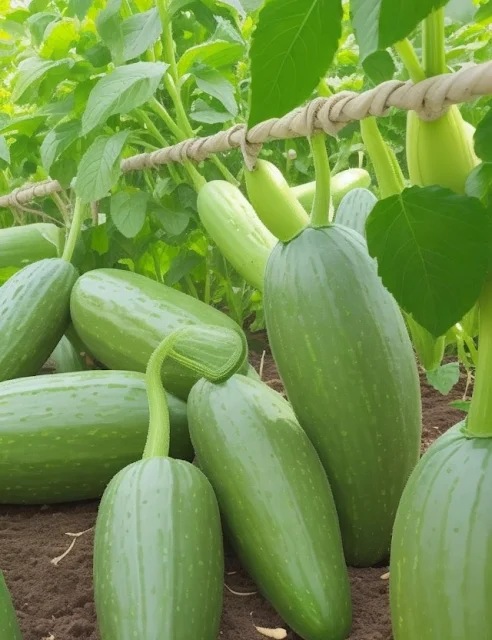Tips and Tricks for Growing Cucumbers
Are you looking to cultivate healthy and bountiful cucumber plants in your
garden? Look no further! In this comprehensive guide, we'll provide you with a
wealth of tips and tricks for growing cucumbers successfully. Whether you're a
seasoned gardener or a novice, these insights will help you achieve a bumper
cucumber crop. Let's dive in!
 |
| Tips and Tricks for Growing Cucumbers |
Here are some tips and tricks for growing cucumbers:
1. Choosing the Right Varieties of cucumbers
Selecting the appropriate cucumber variety is crucial for a successful
harvest. There are two main types to consider: slicing cucumbers and pickling
cucumbers. Slicing cucumbers are ideal for fresh consumption, while pickling
cucumbers are perfect for canning. Popular varieties include 'Marketmore' for
slicing and 'National Pickling' for pickling. Make sure to choose a variety
that suits your preferences and garden space.
2. Optimal Planting Conditions
Cucumbers thrive in warm, sunny locations with well-draining soil. Here are
some key factors to keep in mind:
Sunlight: Cucumbers require at least 6-8 hours of direct sunlight daily.
Soil: Use rich, loamy soil with good organic matter content. Ensure the soil
pH is around 6.0 to 6.8.
Spacing: Plant cucumber seeds or transplants at least 18 inches apart to allow
for proper growth.
3. Proper Watering of cucumbers
Maintaining consistent moisture levels is essential for cucumber growth.
Follow these watering tips:
Deep watering: Water your cucumbers deeply, keeping the soil consistently
moist but not waterlogged.
Mulching: Apply mulch around the plants to help retain moisture and prevent
weeds.
Avoid wetting leaves: Water at the base of the plants to prevent fungal
diseases.
 |
| Proper Watering of cucumbers |
4. Trellising for Space and Airflow
To save space and improve airflow, consider trellising your cucumber plants.
This not only maximizes your garden space but also reduces the risk of
disease. Install a trellis or stakes for the vines to climb, allowing the
cucumbers to hang freely.
5. Fertilization of cucumbers
Cucumbers are heavy feeders, so regular fertilization is crucial. Use a
balanced, all-purpose fertilizer or compost to provide essential nutrients.
Begin fertilizing when the plants have a few true leaves and continue every
3-4 weeks throughout the growing season.
6. Pest and Disease Management
Keep a close eye on your cucumber plants for signs of pests or diseases.
Common cucumber pests include aphids, cucumber beetles, and spider mites. Use
organic insecticides or beneficial insects like ladybugs to control
infestations. Prevent fungal diseases by ensuring good airflow and practicing
crop rotation.
7. Harvesting Techniques of cucumbers
Knowing when to harvest is key to enjoying crisp and flavorful cucumbers.
Here's how to do it:
Size: Most cucumbers are best picked when they reach 6-8 inches in length for
slicing varieties and 3-4 inches for pickling varieties.
Frequency: Harvest regularly to encourage continuous production.
Gentle handling: Use scissors or pruning shears to cut the cucumbers to avoid
damaging the vines.
 |
| Harvesting Techniques of cucumbers |
8. Conclusion
In conclusion, growing cucumbers can be a rewarding experience with the right
knowledge and care. By choosing the right varieties, providing optimal
conditions, and implementing trellising, watering, and fertilization
techniques, you'll be well on your way to a bountiful cucumber harvest. Be
vigilant in pest and disease management, and remember to harvest your
cucumbers at the right time for the best taste and texture. Happy cucumber
gardening!
Frequently Asked Questions
Q1. How long does it take for cucumbers to grow from seeds?
A1. Cucumbers typically take 50 to 70 days from planting seeds to harvesting,
depending on the variety and growing conditions.
Q2. Can I grow cucumbers in containers?
A2. Yes, you can grow cucumbers in containers, provided the container is large
enough and has proper drainage. Choose a compact cucumber variety for
container gardening.
Q3. What are some natural methods to deter cucumber pests?
A3. Natural methods to deter cucumber pests include planting companion plants
like marigolds, using neem oil spray, and introducing beneficial insects like
ladybugs.
Q4. Should I remove male flowers from cucumber plants?
A4. No, it's not necessary to remove male flowers from cucumber plants. Both
male and female flowers are essential for pollination and fruit development.
Q5. How do I store freshly harvested cucumbers?
A5. Store freshly harvested cucumbers in the refrigerator, preferably in a
plastic bag to retain moisture. They can stay fresh for up to a week when
properly stored.
In conclusion, mastering the art of growing cucumbers can be a
rewarding endeavor for any gardener. By implementing the tips and tricks
discussed in this guide, you can significantly improve your cucumber
harvest. Remember to choose the right cucumber variety, provide them with
proper care, and protect them from common pests and diseases. Additionally,
maintaining consistent watering, providing sufficient support, and
harvesting at the right time are key factors in ensuring a bountiful
cucumber crop.
By following these guidelines and continuously learning from your gardening
experiences, you'll be on your way to enjoying delicious homegrown cucumbers
year after year. Whether you're a novice gardener or a seasoned pro, the
satisfaction of plucking fresh cucumbers from your own garden will always be
a delightful reward for your efforts. Happy cucumber growing!
